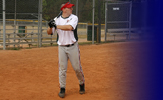| Pre-Swing - Grip |
The Grip
 The grip is one of the most important parts of the swing. It is also, unfortunately, the most often overlooked aspect of the swing. The swing starts with the grip. A poor grip will lead to poor power. There are almost as many 'correct' grips as there are incorrect grips. All of the correct grips, however, have one thing in common. Every correct grip aligns the hands like they are in the 2nd picture on this page. The second knuckles (from your fingertips) should be in alignment with each other. This is most often referred to as lining up the knuckles. It is what allows your arm to work correctly with the bat. The grip is one of the most important parts of the swing. It is also, unfortunately, the most often overlooked aspect of the swing. The swing starts with the grip. A poor grip will lead to poor power. There are almost as many 'correct' grips as there are incorrect grips. All of the correct grips, however, have one thing in common. Every correct grip aligns the hands like they are in the 2nd picture on this page. The second knuckles (from your fingertips) should be in alignment with each other. This is most often referred to as lining up the knuckles. It is what allows your arm to work correctly with the bat.
 If you put your hands together as in picture #1 on this page, and go through the swing motion, you will notice that your wrists roll over early in your swing. This is called cast. Now put your hands together as in picture #2 on this page and go through the swing motion again. Notice how your hands rolled over much later in the swing? This is called whip. Cast and whip are mutually exclusive, meaning you can either do one or the other, but never both in the same swing. And in case you haven't realized it yet, whipping boosts bat speed, while casting drains your swing of bat speed. A proper grip is the foundation of a good swing. Without one, you will never reach your power potential. If you put your hands together as in picture #1 on this page, and go through the swing motion, you will notice that your wrists roll over early in your swing. This is called cast. Now put your hands together as in picture #2 on this page and go through the swing motion again. Notice how your hands rolled over much later in the swing? This is called whip. Cast and whip are mutually exclusive, meaning you can either do one or the other, but never both in the same swing. And in case you haven't realized it yet, whipping boosts bat speed, while casting drains your swing of bat speed. A proper grip is the foundation of a good swing. Without one, you will never reach your power potential.
 The biggest misconception surrounding hitting mechanics is that you are supposed to roll your wrists as you hit the ball. This is absolutely NOT true. You do not roll your wrists until just after you hit the ball. We will revisit this issue later, and I will show you why, but just trust me for now. The biggest misconception surrounding hitting mechanics is that you are supposed to roll your wrists as you hit the ball. This is absolutely NOT true. You do not roll your wrists until just after you hit the ball. We will revisit this issue later, and I will show you why, but just trust me for now.
 I have included several pictures of different grips on this page as a reference. I am also including a picture of the taper or tape job that I prefer on a bat. Tapering the handle allows you to get more power from your lead forearm. I have included several pictures of different grips on this page as a reference. I am also including a picture of the taper or tape job that I prefer on a bat. Tapering the handle allows you to get more power from your lead forearm.
| Incorrect Grip |
Corrected Grip |
My Grip |
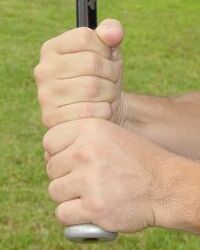 |
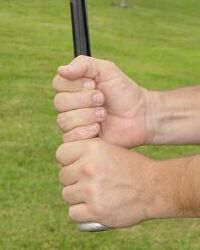 |
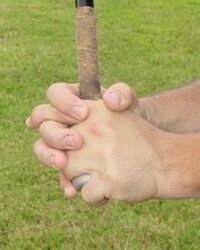 |
| Notice how the knuckles are not properly aligned. This grip will cause a lot of cast. |
Now the knuckles are lined up. This corrects the casting problem |
This grip allows the bat and the bottom wrist to work together much more efficiently.
|
|
|
|
| Pre-Swing - Stance |
The Stance
 The stance covers not only the where and how you stand in the box, but also the why. After all, if you don't know why you are doing something, how can you adjust it? Since how you stand is a little easier to cover, we will start there. The stance covers not only the where and how you stand in the box, but also the why. After all, if you don't know why you are doing something, how can you adjust it? Since how you stand is a little easier to cover, we will start there.
 There are many different ways to stand in the box, and mainly you want to be comfortable, but there are several key aspects to the stance. I don't get too concerned with what I call peripheral stance components. Things such as keeping your hands high or low, laying the bat on your shoulder or holding it more upright. As far as I am concerned, these are more comfort issues then mechanical issues. Where you have your hands during your stance is of relative unimportance, however, once you complete your timing mechanism, your hands need to be in the proper position. We will concentrate on those issues on the 'Coil' page. Here are the things you should concentrate on as far as the stance itself is concerned. There are many different ways to stand in the box, and mainly you want to be comfortable, but there are several key aspects to the stance. I don't get too concerned with what I call peripheral stance components. Things such as keeping your hands high or low, laying the bat on your shoulder or holding it more upright. As far as I am concerned, these are more comfort issues then mechanical issues. Where you have your hands during your stance is of relative unimportance, however, once you complete your timing mechanism, your hands need to be in the proper position. We will concentrate on those issues on the 'Coil' page. Here are the things you should concentrate on as far as the stance itself is concerned.
 You should stand with your feet less than shoulder width apart. You should be on the balls of your feet. Your weight should be about 90% over your back leg, with your knees only slightly bent. You should have some bounce in your feet and knees. As far as I am concerned, anything else is purely a matter of personal preference. You should stand with your feet less than shoulder width apart. You should be on the balls of your feet. Your weight should be about 90% over your back leg, with your knees only slightly bent. You should have some bounce in your feet and knees. As far as I am concerned, anything else is purely a matter of personal preference.
 As for the why you stand like you do, here is my reasoning. If your feet are too far apart, it is tough to get 90% of your weight over your back leg without becoming shorter (shoulders closer to the ground). With your legs less than shoulder width apart, you can stay tall in the box. You are always going to be in a more athletic stance with your weight over the balls of your feet. Also, you don't want to be completely still. If you have no movement in your body, it is going to take more energy to get it moving. As for the why you stand like you do, here is my reasoning. If your feet are too far apart, it is tough to get 90% of your weight over your back leg without becoming shorter (shoulders closer to the ground). With your legs less than shoulder width apart, you can stay tall in the box. You are always going to be in a more athletic stance with your weight over the balls of your feet. Also, you don't want to be completely still. If you have no movement in your body, it is going to take more energy to get it moving.
 Now for the tougher part of the stance, where in the box to stand. Before we talk about that we need to define a few terms. When talking about the batters boxes: Now for the tougher part of the stance, where in the box to stand. Before we talk about that we need to define a few terms. When talking about the batters boxes:
Horizontally means closer to or further from the plate.
Vertically means closer to or further from the pitcher.
Inside means closest to the plate.
Outside means furthest away from the plate.
Front is closest to the pitcher.
Back is closest to the catcher.
 Where to stand is dependant on three main factors, your grip (which determines where in your swing you make contact), your bat, and what pitches you hit well and or poorly. First, your grip and bat will determine where to stand horizontally. You will want to stand where you will make contact with a ball pitched right down the middle, right on the sweet spot of the bat, right at your contact point. You are probably thinking, 'No Kidding,' but too often hitters allow the contours of the batters box determine where they stand. Where to stand is dependant on three main factors, your grip (which determines where in your swing you make contact), your bat, and what pitches you hit well and or poorly. First, your grip and bat will determine where to stand horizontally. You will want to stand where you will make contact with a ball pitched right down the middle, right on the sweet spot of the bat, right at your contact point. You are probably thinking, 'No Kidding,' but too often hitters allow the contours of the batters box determine where they stand.
 An easy way to check how far from the plate to stand is to use a tee. Place a ball on the tee and the tee on the plate. Using your bat, get yourself into your contact position, and move yourself to where you would be hitting the ball right on the sweet spot. Now move about 4 inches away from the plate (I will explain why in the Stride portion of this site). This is how far from the plate you should stand. An easy way to check how far from the plate to stand is to use a tee. Place a ball on the tee and the tee on the plate. Using your bat, get yourself into your contact position, and move yourself to where you would be hitting the ball right on the sweet spot. Now move about 4 inches away from the plate (I will explain why in the Stride portion of this site). This is how far from the plate you should stand.
 Where to stand vertically, is a whole different story. Vertical positioning depends more on whether you want to hit pitches in your chest or at your thigh. The higher the pitch you want to hit, the closer to the front of the box you should stand. This will take some time. Once you feel comfortable with a proper grip, and your new mechanics, you will need to hit a lot of BP to figure where, vertically you want to stand. Vertical positioning is more fluid than horizontal placement in the box. Often times you will move vertically based on the pitcher you are facing. If he is pitching with a lot of arc, you will likely want to move back in the box. If he is pitching flat, you will probably want to move forward in the box. Where to stand vertically, is a whole different story. Vertical positioning depends more on whether you want to hit pitches in your chest or at your thigh. The higher the pitch you want to hit, the closer to the front of the box you should stand. This will take some time. Once you feel comfortable with a proper grip, and your new mechanics, you will need to hit a lot of BP to figure where, vertically you want to stand. Vertical positioning is more fluid than horizontal placement in the box. Often times you will move vertically based on the pitcher you are facing. If he is pitching with a lot of arc, you will likely want to move back in the box. If he is pitching flat, you will probably want to move forward in the box.
Continue On To The Coil
|
| A Good Stance |
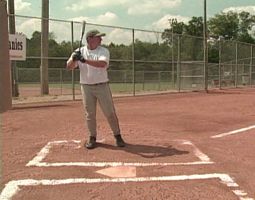 |
| I am as tall as I can be, my weight is back, and I am on the balls of my feet. |
|
|
|
|
|

